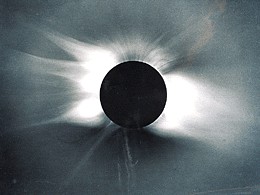1) corona
[英][kə'rəʊnə] [美][kə'ronə]


日冕
1.
more and more observational data about coronal loops have been obtained.


日冕加热是太阳物理中一个基本问题。
2.
Using some data observed with SXT/HXT aboard Yohkoh and the Nobeyama Radioheliograph (NoRH) on 1998 April 23, a comprehensive study on the soft X ray coronal mass ejection (CME) on solar SE limb shows there were two magnetic dipole sources(MDSs), one magnetic capacity belt (MCB) between MDSs, one neutral current sheet (NCS) and only a few activation sources (ASs).
使用Yohkoh卫星上的SXT/HXT和Nobeyama射电日像仪 (NoRH)观测资料 ,对1 998年 4月 2 3日发生在日面东南边缘上的软X射线日冕物质抛射 (CME)作了分析研究 ,结果表明 ,软X射线CME具有两个磁偶极源 (MDSs) 。
3.
Alfven waves propagate to go to a top of coronal loop by the photoshere along both feet of arch magnetic line of force.
来自太阳光球层的Alfven波沿着日冕环的拱形磁感线两足向上传播,在冕环的顶部两反向传播的波相遇,强烈的不稳定性可能激发起等离子体湍动。
2) solar corona


日冕
1.
Optical observations of the solar corona at total solar eclipse


日全食时的日冕光学观测
2.
The solar total eclipse provides a good opportunity to observe the solar corona and is of significance for the researching of the corona [1,2] .
在1997 年3 月9 日日全食时, 我们于黑龙江省漠河市( 西林吉) 作了一系列日冕的照相观测不同感光的日冕像上显示出赤道东西的宽冕流、两极区冕洞、极羽和20 多条极射线等结构特征本文综合一些日冕像的形态结构和亮度测量结果,给出日冕的形态结构图、等亮度图、两极区和赤道区东西的亮度分布
3) Coronal
[英]['kɔrənl] [美]['kɔrənəl, 'kɑr-, kə'ronəl]


日冕
1.
Generally,the solar high energy particles in the flares are believed to be accelerated in two stages:acceleration by abrupt release of magnetic energy in the first stage and coronal diffusive shock wave or stochastic acceleration in the second stage.
考虑日冕区加速中相对论性粒子的扩散激波加速,结果表明:(1)粒子随时间的分布,其主要特点是随时问增加,一定能量的粒子分布迅速增加至最大后下降,并且能量越大,其最大就越向着大时间移动;(2)给出了相应的时间积分谱,它正比于具有指数截止的粒子动量的幂律。
6) coronal magnetic field


日冕磁场
1.
A series of recent works using the radio spectrometer(with high time and frequency resolutions) and Nobeyama Radio Heliograph(with high spatial resolution) for analysis coronal magnetic field and reconnection are summarized in this paper.
总结了近期用射电频谱仪(高时间和高频谱分辨)和野边山射电日像仪(高空间分辨)以及国内外其它空间和地面设备分析日冕磁场和重联的系列工作。
补充资料:日冕
| 日冕 solar corana 太阳大气的最外层。形状随太阳活动大小而变化。可人为地分为内冕、中 冕和外冕3层。内 冕从色球顶部延伸到1.3太阳半径处;中冕从1.3太阳半径到2.3太阳半径,也有人把2.3太阳半径以内统称内冕。大于2.3太阳半径处称为外冕(以上距离均从日心起算)。广义的日冕可包括地球轨道以内的范围。日冕主要由高速自由电子、质子及高度电离的离子(等离子体)组成。其物质密度小于2×10-12 千克/米3,温度高达1.5×106~2.5×106K。由于日冕的高温低密度,使它的辐射很弱且处于非局部热动平衡状态,除了可见光辐射外,还有射电辐射,X射线,紫外、远紫外辐射和高度电离的离子的发射线(即日冕禁线)。 白光日冕有3个分量:①K冕。在2.3太阳半径以内,由自由电子散射光球的连续光谱。②F冕。在2.3太阳半径以外,起源于黄道面内行星际尘埃粒子散射光球的光,它的光谱中有夫琅和费线,F冕又称为“内黄道光”。③E冕。又称L冕,是日冕气体离子发射线的光。日冕的磁场强度约1/10000~1/100特斯拉,随距日面距离的增加而减小。
|
说明:补充资料仅用于学习参考,请勿用于其它任何用途。
参考词条
